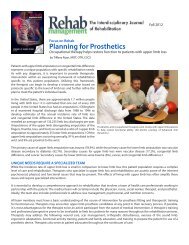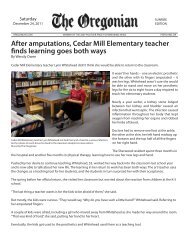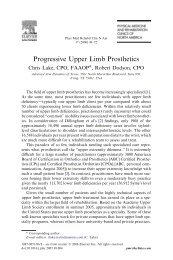Prosthetic Advances - Zach T. Harvey, CPO - Advanced Arm Dynamics
Prosthetic Advances - Zach T. Harvey, CPO - Advanced Arm Dynamics
Prosthetic Advances - Zach T. Harvey, CPO - Advanced Arm Dynamics
Create successful ePaper yourself
Turn your PDF publications into a flip-book with our unique Google optimized e-Paper software.
efore. Dynamic response feet constructed predominantly<br />
of carbon fiber, urethane, and titanium provide good<br />
energy return and ground accommodation (2–9). Microprocessor<br />
knees have enabled safer, more versatile, and<br />
more efficient ambulation (10–14). Upper extremity devices<br />
are rapidly changing to include more degrees of<br />
freedom, and becoming more intuitive and responsive,<br />
as a direct result of government-funded initiatives (15).<br />
<strong>Prosthetic</strong> feet, knees, hands, and other components are<br />
available to suit virtually any specialized need or activity<br />
where a standard prosthesis is not appropriate (16). Interface<br />
and suspension are slowly improving as manufacturers<br />
compete to produce a better product. A myriad<br />
of aesthetic options are available, including stunningly<br />
realistic high definition silicone restorations, helping with<br />
acceptance of body image.<br />
Despite the vast number of products and techniques<br />
available for the prosthetist to attempt to restore the loss<br />
of limb(s), technological limitations persist. Perhaps the<br />
most critical part of the prosthesis is the socket and<br />
interface. Patients consistently rate comfort as being more<br />
important than either function or cosmesis (17). The most<br />
technologically sophisticated prosthesis will not be used<br />
if it is not comfortable. The struggle to provide the perfect<br />
socket requires patience, perseverance, and acceptance<br />
when a realization is met that perfection is never fully<br />
attainable. That said, emerging materials and technologies<br />
continue to evolve and address the needs of the combatinjured<br />
amputee; these advances will gradually migrate to<br />
the arena of civilian amputee care in coming years.<br />
Lower extremity prosthetic advances<br />
It is well known that persons with amputation require<br />
increased energy expenditure to ambulate compared to<br />
age-matched non-amputees, and that the more proximal<br />
the level of amputation(s), the higher the increase in<br />
energy requirements (18–22). Additionally, in order to<br />
successfully ambulate, compensatory gait patterns are<br />
necessary but may lead to low back pain, premature<br />
degenerative joint disease, and variety of other maladies<br />
(23–29). The sound side ankle plantarflexes nearly 20<br />
degrees (30) during late stance and, among the lower<br />
extremity joints, is the greatest propellor during over<br />
ground gait (31). The iwalk BiOM (Bedford, MA) is the<br />
first commercially available foot and ankle to generate<br />
power in the form of active plantarflexion during late<br />
stance in gait (Fig. 1). Bionic and biomemetic controls<br />
acquire information from on-board sensors and send<br />
output to an actuator, which in turn moves the ankle as<br />
programmed. Preliminary data from a study conducted at<br />
the Center for the Intrepid in San Antonio, TX, has found<br />
the energy consumption of those unilateral transtibial<br />
BiOM wearers comparable to able-bodied controls (32).<br />
Whereas traditional prostheses generally restore only the<br />
skeletal loss following an amputation, the BiOM succeeds<br />
in restoring some motor aspects of neuromuscular loss as<br />
well. This technology should continue to improve with<br />
better battery technology, more sophisticated algorithms,<br />
and as other manufacturers attempt to compete in this<br />
market. Powered ankle and knee combinations are the<br />
next logical step of development and will follow suit<br />
with much of the recent progress made in upper extremity<br />
prosthetics. Pattern recognition shows some promise as a<br />
highly intuitive control scheme for the lower as well as<br />
upper extremity and would enhance the responsiveness of<br />
such systems (33).<br />
During level ground-walking, normal gait reveals 15 to<br />
20 degrees of knee flexion during loading response (34).<br />
This serves as a shock absorbing mechanism and is one of<br />
the key determinants of gait (35,36). Many microprocessor<br />
prosthetic knee joints are now designed with a feature<br />
called “stance flexion” and allow the user to push freely<br />
into the knee joint, allowing it to bend, and later pulling<br />
back in the socket to progress over the prosthesis. Few<br />
persons with transfemoral amputations, especially those<br />
with long, strong residual limbs, utilize this stance flexion<br />
feature (37,38), and prefer to power back in the prosthesis,<br />
keeping the knee joint locked throughout the entire phase<br />
of stance because of the feeling that the knee is giving<br />
way. It is highly possible that this contributes to the high<br />
prevalence of low-back pain associated with transfemoral<br />
amputees (39).<br />
Traditional prosthetic knees are passive in nature and<br />
are designed to balance stability with mobility during the<br />
gait cycle. Microprocessors have helped to improve the<br />
timing of this balance and even anticipate actions such<br />
as the stumble recovery feature of the Otto Bock Cleg<br />
(Minneapolis, MN). The Ossur Power knee (Aliso<br />
Viejo, CA) is the first commercially available knee to<br />
FIGURE 1 The BiOM powered ankle is the first commercially<br />
available device to deliver powered plantarflexion. This is thought to<br />
improve walking efficiency and lessen compensatory gait deviations.<br />
Photo courtesy of iWalk, Bedford, MA.<br />
Copyright © 2012 by the Southern Orthopaedic Association VOLUME 21, NUMBER 1, SPRING 2012 59










